Bagram Airfield, Afghanistan, is being configured for the long term because an Air Force presence will likely extend well beyond the planned 2014 handover of security to Afghanistan’s indigenous forces. New aerial port facilities opened at Bagram recently, as they have at USAF’s other main base in the country, Kandahar. Likewise, new dormitories have risen near the abandoned, rotting plywood huts they replace. New office buildings are going up. The runways, ramps, and hangars are in good condition and are more than ample for the heavy traffic at the base, whose aerial port facilities are the busiest in the Air Force.
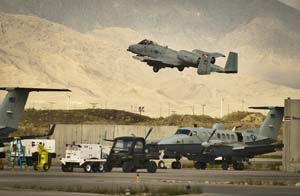 | ||
|
An A-10 takes off, passing an MC-12 Liberty at Bagram Airfield, Afghanistan. Bagram is undergoing a facelift despite the planned 2014 handover of security to Afghan forces. (USAF photo by Capt. Raymond Geoffroy) |
“We’re going to be here, in some capacity, in support of the Afghans beyond 2014,” said Brig. Gen. Thomas H. Deale, commander of Bagram’s 455th Air Expeditionary Wing. “The exact structure of that is to be determined, but since the beginning [of Operation Enduring Freedom], Bagram has been a central hub for both logistics and operations affecting the entire [area of responsibility] … and I would expect in some way, shape, or form, Bagram will continue to do that as we progress.”
The dorms replace temporary B-Huts that have been “out in the elements for five to seven years,” Deale said. The plywood structures have delaminated, become unsound, and are overrun with vermin. “There’s a risk based on their condition,” he said, describing the construction as a matter of treating airmen right.
“We have roughly 30,000 people here, inside the wire,” Deale said. Beyond 2014, Bagram will not have many. “We do not need that capacity in an enduring presence,” he noted. “So, what I would envision for Bagram is a much smaller footprint, with appropriate facilities to support the force structure, extended beyond 2014, with the ability to fall in on it in the future.” The USAF operation will likely consolidate to just one side of the runway, “back to the way Bagram originally was” in the early 2000s, before the US expanded the airfield.
The US still makes full use of the expansion, because the Air Force has not slowed down in Afghanistan. Every few hours, like clockwork, a brace of A-10C Thunderbolts accelerates down the long runway. For the next six to 10 hours, they’ll offer on-call close air support to any joint terminal attack controller in the eastern part of the country.
JTACs in Charge
The A-10s fly whether their awesome firepower has been called for—or not. If not, they put their sensors to work keeping watch over ground forces in their assigned area of coverage—another element in the vast intelligence, surveillance, and reconnaissance network over the country.
Lt. Col. Paul Zurkowski, commander of the 104th Expeditionary Fighter Squadron at Bagram, said his unit of 24 A-10s—comprising aircraft from several Air National Guard units and flown by members of all of them—flies 22 “lines,” or missions a day, with 24 hours of coverage.
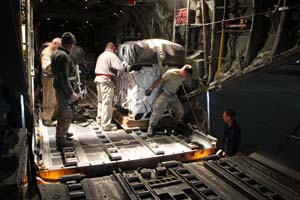 | ||
|
Airmen load a West Virginia ANG C-130 with parachute-rigged bundles of “gasoline and groceries” to be dropped to a forward operating base in eastern Afghanistan. (Staff photo by John A. Tirpak) |
“We have three shifts,” Zurkowski said. “Eight in the morning, eight in the afternoon … and then we have six at night.” These missions are “preplanned” in the sense that A-10s will be up and in their area of responsibility, called RC East, at a specified time. They don’t have planned fixed kinetic targets, but are on-call for JTACs if there are troops in contact—TIC—with the enemy. Their missions, however, have them using their onboard sensors, “looking at interest points on the ground,” Zurkowski said. These points are places where ground forces have consistently encountered the enemy or at positions where the enemy has previously set up firing positions.
The A-10s will also escort ground convoys, flying ahead of the ground units to look for ambushes, and provide top cover for HH-60 Pave Hawk rescue helicopters dispatched to recover injured troops or flying secret missions.
The Warthogs take off with a consistent weapons load that includes its massive 30 mm internal gun, white phosphorous rockets, countermeasures, and four 500-pound Joint Direct Attack Munitions, or JDAMs, of various configurations.
There’s no hard rule, but the units measure success by whether A-10s respond to troops in contact within 12 minutes, Zurkowski said.

| ||
|
On the sprawling Bagram flight line, A1C Mark Anderson of the 455th Expeditionary Aircraft Maintenance Squadron loads liquid oxygen into an A-10 from the Maryland Air National Guard. (Staff photo by John A. Tirpak) |
The A-10s are not the only providers of CAS in the region. Weighty B-1 bombers with heavy bomb loads orbit the area, and at night the A-10s coordinate with AC-130 gunships, especially when supporting special operations teams. They also work with Army “air weapons teams” comprising OH-58 Kiowas and AH-64 Apaches. All can provide “fire support for the JTAC at low altitude.”
Most of the time, two A-10s can handle whatever calls come in, though “we’ve stacked four in the area,” Zurkowski said. However, the lines of authority are clear, and the JTAC is in charge.
“The JTAC will coordinate fires. The JTAC answers to the … on-scene [ground] commander,” usually a lieutenant to a major.
Though every mission involves some ISR collection, about “70 percent of the time, we’re responding to a priority or a troops in contact” request.
And close air support is just one of a broad range of missions the Air Force performs from Bagram. Just up the runway, HH-60 Pave Hawks stand alert, ready to respond if a coalition soldier is wounded in battle.
Remotely piloted aircraft share the ramp with the HH-60s, along with a large contingent of Army attack, scout, and utility helicopters. A small detachment of Marine Corps EA-6B Prowler electronic warfare jets are there as well, as are a mix of USAF and Army C-12 variants that provide a manned ISR capability.
On the other side of the airfield, Air Force, coalition, and contractor cargo aircraft land and take off in a constant flow, bringing in supplies and taking away equipment as part of the broad US withdrawal from the country. Across the base, troops from a melting pot of NATO and coalition armed forces carry out assigned duties.
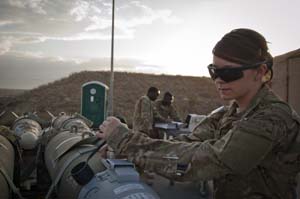
| ||
|
A1C Mary Wiuff, a munitions systems specialist, checks a GBU-38’s guidance system at Bagram. Some 30,000 people are currently “inside the wire” at the base. (USAF photo by Capt. Raymond Geoffroy) |
Deale acknowledged Bagram’s sprawling, multimission nature, but insisted it is “not about strategic-level operations.” Rather, he said, Bagram is a tactical base, focused on providing “every ounce of support we can” to the soldier in the field. That, Deale said, is “our sole purpose, … so he is successful in his mission and … that he gets off the battlefield safely.”
The nascent Afghan Air Force doesn’t have a presence at Bagram, but it will. The base will likely host Afghanistan’s C-27 airlifter fleet, and the new Afghan light strike aircraft will be based there.
In February, Bagram’s contingent of F-16s and Kandahar’s A-10s swapped bases.
“Part of the reason for moving the A-10s up here is to have a unit to partner the Afghan units with, for close air support and light attack,” Deale explained. The Afghans can take advantage of operating with a USAF unit having a similar mission, “if there is an enduring presence here with that capability.”
The “graveyard” of junked Soviet-type aircraft seen at some bases in the country is a stark example of how not to foster a new Afghan Air Force, Deale said.
“The equipment they use, … the capabilities they develop, have got to be supportable by Afghanistan, … by the economy, by the Afghan education system,” he said. The sophisticated Soviet aircraft handed over to the country when Russia created a client state there in the 1980s were more than Afghanistan could manage within its resources, both financial and human.
“There was no way that kind of fleet of aircraft was going to be sustainable,” he said. Instead, the US approach has been to help Afghanistan develop a solution comprising C-27s, Mi-17 helicopters, and “a light attack capability” still to be determined. The mix will be manageable by the Afghans such that “we will not have to continue to provide support and services” to facilitate their capabilities, Deale said.
Partnering with the Afghan Air Force on the C-27s and Mi-17s takes place at Kandahar, where Deale also served as commander before his assignment at Bagram.
Although USAF has not had to perform air sovereignty for Afghanistan, “they live in a rough neighborhood,” Deale observed, and neighboring countries possess power projection capabilities. Afghanistan shares borders with Iran, Pakistan, several former Soviet republics, and even a sliver of China.
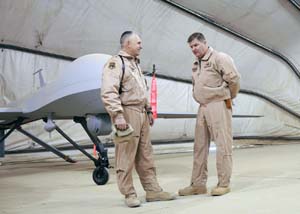
| ||
|
Brig. Gen. Scott Dennis (l) speaks with Brig. Gen. Thomas Deale at Kandahar Airfield in Afghanistan, where Deale served as commander before his assignment to Bagram. (USAF photo by SSgt. Heather Skinkle) |
Air Force officials have said privately that Afghanistan may also adopt one of the many variants of the C-12, which in Army and Air Force versions ply the skies of Eastern Afghanistan, offering multimode, crewed intelligence support to troops on the ground.
Deale said USAF added six additional USAF MC-12 Liberty aircraft to the Bagram fleet after the end of their mission in Iraq last year. The Army operates “several different C-12 configurations” from the base.
“They make a difference quite a bit on the battlefield with the advanced ISR capabilities that they bring,” he said. They are superior to RPAs in some ways because “they are a lot less restricted as far as [how] weather impacts their ability to conduct their mission.” The crews are much more integrated with the ground forces they support. They have “much closer, much more direct tactical relations.”
One mission probably not in the cards for Bagram is to host air refueling aircraft. Deale noted that Afghanistan doesn’t have any domestic fuel production capability, so the fuel would have to be brought in “somehow, so it almost defeats the purpose of basing a tanker here.”
Out of the 30,000 people on the base, some 5,000 are Afghan nationals, Deale said, and this, too, helps pave the way for Afghanistan to take over its own security.
Although there’s a danger that among those 5,000 are Taliban sympathizers who could “cause some sort of disruption,” Deale said, “we do quite a bit to mitigate that risk.” Long lines of workers wait to enter the base every day, and they go through screening “very similar to what you go through in the United States to get on board an airliner.”
Still, that doesn’t seem to be enough. There were five so-called “green-on-blue” attacks in just one week in August, which Defense Secretary Leon E. Panetta said has him “very concerned.” As such, Panetta said he is working with Marine Corps Gen. John R. Allen—the top commander of US and coalition forces in Afghanistan—on a range of measures to “stop these attacks,” including implementing a more thorough vetting process and an increased intelligence presence.

| ||
|
Two South Korean HH-60 Pave Hawks take off from Bagram. Coalition and contractor aircraft constantly come and go from the airfield. (USAF photo by Capt. Raymond Geoffroy) |
Maj. Gen. Tod D. Wolters, former commander of the 9th Air and Space Expeditionary Task Force-Afghanistan, said such events can undo years of hard-earned trust and can force commanders to rethink troop ratios for those assigned to work with the Afghans. “It’s something that has to be looked at day in and day out,” said Wolters during an August Mitchell Institute event.
About 20 people a week are put off the base and not permitted to return—roughly “half a percent,” Deale observed. The infractions are often due to inattention, but Deale said, “We’re … not naïve.” USAF recognizes that some of those who break the rules may be enemies trying to infiltrate or case the base.
“It really drives home the fact that we’re serious about the rules. And for many of them, this is their livelihood,” he said. “If you lose access, you lose your job.” The jobs, by Afghan standards, are well paying, and to lose one hurts.
Deale said the biggest challenge at Bagram is recognizing the complex nature of the conflict. Attitudes within the country swing back and forth about the American presence, but the tone shifts dramatically if there’s an incident—such as when US troops mistakenly burned several Korans earlier in the year.
A Changing Dynamic
The incident was “clearly a mistake,” Deale said, made “by very junior enlisted members who were directed to dispose of this material. There was no harm meant; it wasn’t meant to be disrespectful.” Likewise, occasional “navigational errors” made with RPAs “create cross-border issues.” These would be small problems in another theater, but in Afghanistan and nearby countries, “you see it resonate at the strategic level.” Late last year, a stealthy American RPA went down in Iran, which recovered its wreckage. The event was a propaganda coup for the Iranian government and possibly a technological bonanza as well.
Overall, “the dynamics of this theater are changing about every six months. So when you come into theater, if you’re relying on previous experiences, you’re out of touch,” Deale asserted. He makes it a priority to ensure that “everyone is aware of what the context of the fight is today,” so airmen understand “how to conduct themselves in the air or on the ground, in a way that prevents those tactical-level issues from growing” into major political crises.
The US is already starting to “retrograde”—move—equipment out of Afghanistan, either to pre-positioning stocks in the Middle East or all the way back to the States.
“We’re still looking at the smartest way to remove equipment from the battlefield,” Deale observed. It’s not clear whether Bagram will continue to be a transshipment point, where large gear such as vehicles are brought in on the surface but leave on large “gray tail” USAF transports. Alternatively, cargo jets may pick up gear directly from some of the forward operating bases that have a suitable airfield. Only military jets may do such work; it’s not safe enough to send commercial freighters out to the FOBs.
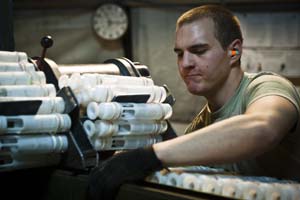
| ||
|
SrA. Zane Gorman loads high-explosive incendiary rounds into containers for A-10s at Bagram. The airfield is a tactical base focused on supporting troops in the field. (USAF photo by Capt. Raymond Geoffroy) |
Despite the drawdown, Deale said, “I have no challenge with morale and motivation across the wing. Every airman understands his direct role in the mission. … And they’ll put up with a lot: long duty hours, harsh working environments. … They’ll put up with rocket attacks because they understand how important it is and how they contribute to the mission.”
Two schools of thought seem to be coalescing around how the enemy will react to the planned exit of US forces in 2014. One suggests that the Taliban and its allies will lay low, wait until the US departs, and then make a renewed grab for power. The other suggests that the Taliban will make a full military press through the US departure and then declare that it defeated the US militarily and drove it out of the country.
Deale said the US, unequivocally, is “achieving tactical success” in Afghanistan, and he doesn’t see a need for more capability right now. Moreover, after the Taliban made grandiose announcements about the launch of its spring fighting season, their military efforts have been spotty.
However, “if we need additional resources, we’ll bring more resources into the theater,” Deale said. The US has demonstrated that it will boost its capabilities in the country “when we need to, based on what the [operating] tempo is … and there’s no doubt in my mind that should the ground situation dictate that we need more resources, we’ll do the same. We aren’t there yet,” he added.
The US has adequate capabilities “in theater to meet what the requirement is for our ground forces: to be mission successful, to be safe.”
| A Study in Restraint
A reporter accompanied an Air Force crew on a recent “airland” delivery, meaning the C-130 set down at a small runway, taxied to a revetment constructed of old conex containers, unloaded its cargo, and make a swift departure.
The area was considered “hot,” and the pilot made a series of highly aggressive turns in making his descent, so enemies on the ground would have as small and unpredictable a target as possible. Everyone on the aircraft was required to wear helmets and body armor, given that C-130s sometimes return from such missions with extra holes after being hit by small-arms fire. After the airplane landed and taxied in, two security forces airmen jumped off the C-130 and took up positions at the wingtips, ready to protect the crew and aircraft while ground personnel unloaded the cargo. The operation went smoothly, and the pallets of food, water, fuel, and equipment, which had taken about 45 minutes to load, were off the airplane in less than seven minutes. However, the C-130 did not quickly button up and taxi back out. It remained in the revetment, engines turning. The crew had received instructions to stand by. In a few minutes, a small group of figures appeared from around one of the conex containers. Soldiers of the 1st Infantry Division, as advertised by the “Big Red One” patches on their sleeves, led three men in traditional Afghan attire, wearing blacked-out goggles, “Mickey Mouse” ear protectors, and plastic handcuffs. The soldiers were in full battle gear. The prisoners were effectively blindfolded by the goggles and unable to hear, and the soldiers patiently but firmly led them to seats across from the reporter. One of the crew members pointed out that one of the detainees, despite being blindfolded and handcuffed, had just attempted to take a weapon away from a soldier. Under the circumstances, it would not have been surprising to see him thrown to the floor and held down with a knee or boot, at gunpoint. Instead, the three were simply positioned to sit down in the canvas troop seats. One of the soldiers—baby-faced and red-haired—spoke loudly and sternly to them in their language, perhaps Pashto. The only rebuke from these soldiers was to insist the three men sit straight up and not recline in their seats. They did so and remained flanked by soldiers wearing latex gloves. When one continued to complain that his handcuffs were too tight, a soldier cut the plastic bonds and firmly placed the detainee’s hands on his knees, to let him know that’s where they should stay. The prisoner, obviously grateful, took the hint. At all times, the soldiers treated the prisoners with firmness but civility. They suffered no humiliating treatment, and one soldier even steadied a fearful detainee as the aircraft climbed out on what was, in all likelihood, the man’s first flight. The soldier gave him a small bag, just in case. Upon arrival at Bagram, the soldiers led the prisoners off the airplane. It is highly unlikely that this little scene was staged for the benefit of the visiting journalist. Neither the pilot nor loadmasters knew they would be taking detainees back to Bagram, and when the prisoners appeared at the back of the airplane, the media escort quickly warned: “No pictures of this.” Later, one of the crew members said if the commanders at Jalalabad had known a reporter was aboard, the prisoners probably wouldn’t have been boarded. From time to time, sad evidence emerges that soldiers in this war, perhaps frustrated by its length and the losses they have suffered among their comrades, have resorted to treating the enemy in humiliating ways, sometimes posing for the camera as they do so. But on that hot day in Jalalabad this summer, the soldiers treated their enemy with professionalism, despite being given ample incentive to do otherwise. —John A. Tirpak |
|
Close Air Support, Refined and Evolved Compared with the ad hoc coordination of close air support that characterized the early phases of Operation Enduring Freedom, CAS as practiced in Afghanistan today is a refined process taking full advantage of years of hard experience and specialized technology developed with the mission in mind.Brig. Gen. Thomas H. Deale, commander of the 455th Air Expeditionary Wing here, said, “I’ve been an A-10 pilot my whole career,” and “we have got our ability to integrate aerial operations and direct support to the ground force at the highest degree I’ve ever seen.” He explained that USAF has “matured the theater air-to-ground system,” to include joint terminal attack controllers—airmen embedded with ground troops who call in air strikes—as well as the air operations center and “the aircraft themselves.” The hallmarks of this coordination lie with the transition of the A-10 to a digital platform, able to take full advantage of data sharing systems, and having the ROVER (Remotely Operated Video Enhanced Receiver) system in the hands of JTACs. “If you ask what is working better than it should,” then the coordination of CAS falls in that category, Deale said. “Granted, we have had two wars and 10 years of development of that, but … our ability to integrate direct fire and support of our ground forces is extremely good.” Using Litening targeting pods to survey the scene, A-10s can share imagery digitally with JTACs using the ROVER set. The JTACs can then see everything the pilots see, said Lt. Col. Paul Zurkowski, a deployed A-10 squadron commander. The JTACs can even manipulate the A-10’s Litening pod, slewing it to look at the areas they want to see. Both the pilot and the JTAC can simultaneously see enemy positions or places the JTAC wants the fighter to attack. “They can vector our pods to where that specific individual or vehicle or house is. So the ROVER is a great capability,” Zurkowski noted. Up to five hours of four-channel imagery can be recorded and mined for useful “stills” that can be sent back to the ground troops, he said. Also, “we can change the ‘lens’ that we look through on the pods,” to go from superwide and big to small, to put a scene in context. At the tightest resolution, “now you can count the number of doors on the house,” he said. “If you zoom in, you can find people who are located up to four miles away.” |